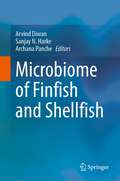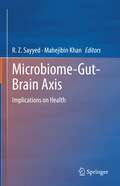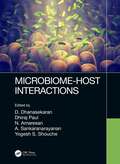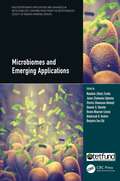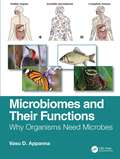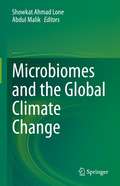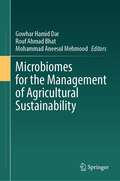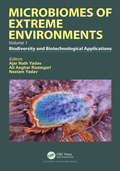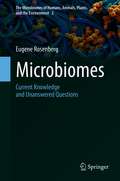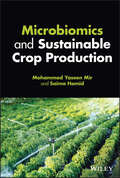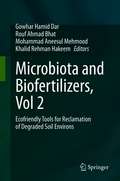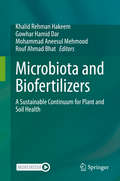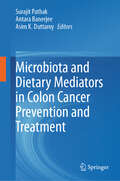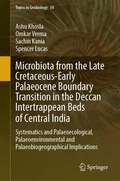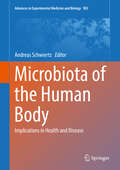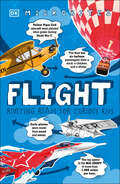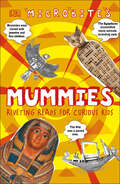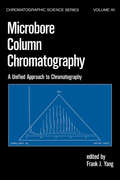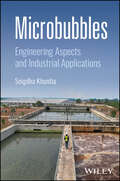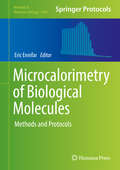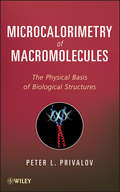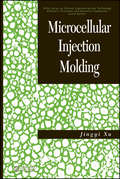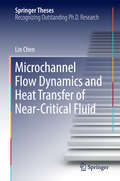- Table View
- List View
Microbiome of Finfish and Shellfish
by Arvind Diwan Sanjay N. Harke Archana PancheThis book helps us to understand the importance of the microbiome associated with finfish and shellfish inhabiting different locations and varied environmental and biological situations. It covers modern molecular tools for identifying microbiome composition and their precise identification at the species level. The book also covers the molecular structural composition of individual microbes, metabolite resources from microbiome species, their functional properties, and production aspects. Notable, the book covers the microbiome applications in the gut systems of finfish and shellfish to the digestion, nutrition, growth, reproduction, immune system, and vulnerability of the host to diseases. It also reviews diversity and functional properties, relationships with diseases, health status, data on species-specific metagenomics, and probiotic research. It highlights the relevance of microbial communities for the development of new and innovative bio-products to build bio and pharmaceutical industries, including aquaculture. This book is an invaluable source for researchers and professionals involved in fishery science, fisheries and aquaculture, fish biotechnology, and fish microbiology and pathology
Microbiome, Investigation Notebook with Article Compilation
by The Lawrence Hall of ScienceNIMAC-sourced textbook
Microbiome, Investigation Notebook with Article Compilation [Grade 6]
by The Lawrence Hall of ScienceNIMAC-sourced textbook
Microbiome-Gut-Brain Axis: Implications on Health
by R. Z. Sayyed Mahejibin KhanThe book highlights the importance of prebiotics, probiotics and synbiotics in the signalling mechanism between gut microbiota and brain, also referred to as the gut-brain axis. A stable gut microbiota is essential for normal gut physiology and overall health, since it assists in proper signalling along the brain–gut axis. The book describes how the cross talks between gut microbiota and brain, not only regulate gastro-intestinal functions but also ensure proper functioning of cognitive behaviour and immunological functions. The various chapters describe probiotic microorganisms that colonize gastrointestinal tract and provide an array of health benefits to the host. It further elaborates about certain non-digestible oligosaccharides (prebiotics) are easily fermented by specialist microbes in the gut, to produce health-promoting metabolites and inhibit the growth of pathogenic bacteria. This book is useful for students, researchers and scientists in the field of microbiology, food science and nutrition. It is also meant for industry experts involved in developing nutraceuticals.
Microbiome-Host Interactions
by Dhiraj Paul A. Sankaranarayanan N. Amaresan D. Dhanasekaran Yogesh S. ShoucheMicrobiota are a promising and fascinating subject in biology because they integrate the microbial communities in humans, animals, plants, and the environment. In humans, microbiota are associated with the gut, skin, and genital, oral, and respiratory organs. The plant microbial community is referred to as "holobiont," and it is influential in the maintenance and health of plants, which themselves play a role in animal health and the environment. The contents of Microbiome-Host Interactions cover all areas as well as new research trends in the fields of plant, animal, human, and environmental microbiome interactions. The book covers microbiota in polar soil environments, in health and disease, in Caenorhabditis elegans, and in agroecosystems, as well as in rice root and actinorhizal root nodules, speleothems, and marine shallow-water hydrothermal vents. Moreover, this book provides comprehensive accounts of advanced next-generation DNA sequencing, metagenomic techniques, high-throughput 16S rRNA sequencing, and understanding nucleic acid sequence data from fungal, algal, viral, bacterial, cyanobacterial, actinobacterial, and archaeal communities using QIIME software (Quantitative Insights into Microbial Ecology). FEATURES Summarizes recent insight in microbiota and host interactions in distinct habitats, including Antarctic, hydrothermal vents, speleothems, oral, skin, gut, feces, reproductive tract, soil, root, root nodules, forests, and mangroves Illustrates the high-throughput amplicon sequencing, computational techniques involved in the microbiota analysis, downstream analysis and visualization, and multivariate analysis commonly used for microbiome analysis Describes probiotics and prebiotics in the composition of the gut microbiota, skin microbiome impact in dermatologic disease prevention, and microbial communities in the reproductive tract of humans and animals Presents information in a reachable way for students, teachers, researchers, microbiologists, computational biologists, and other professionals who are interested in strengthening or enlarging their knowledge about microbiome analysis with next-generation DNA sequencing in the different branches of the sciences
Microbiomes and Emerging Applications (Multidisciplinary Applications and Advances in Biotechnology)
by Nwadiuto Diuto EsiobuThis book covers a range of important topics and recent advances in metagenomics, microbiomes and their emerging applications, including microbiota transplantation and its health implications. It also discusses microbiome composition and development in humans. The contributors of this volume provide detailed information on prebiotics and probiotics for enhanced human health. They also introduce microbiomes as the next frontiers in medicine, agriculture, industry and environment. A chapter is presented that discusses probiotic research studies in Nigeria and Canada that led to the discovery of Lactobacillus pentosus KCA1. The book contains timely knowledge and will be useful reference material for scientists and researchers working in the fields of food and agricultural biotechnology, biopharmaceuticals and medical biotechnology, fermentation technology, environmental biotechnology, microbiomes and microbial biotechnology and health care. Emphasizes recent advances in metagenomics and microbiomes and their emerging applications in medicine, agriculture, industry and environment Provides detailed information on prebiotics and probiotics for enhanced human health Introduces microbiomes as the next frontiers in medicine, agriculture, industry and environment Reviews microbiota transplantation, health implications and the way forward Discusses microbiome-epigenetic-host interactions essential for the physiological functions of the body in health and disease Nwadiuto (Diuto) Esiobu, Ph.D., is a Professor of Microbiology and Biotechnology at Florida Atlantic University, Boca Raton, FL, USA, and the President and Founder, of Applied Biotech Inc. and ABINL. James Chukwuma Ogbonna, Ph.D., is a Professor of Microbiology and Biotechnology, and Director, National Biotechnology Development Agency, South East Zonal Biotechnology Centre, University of Nigeria, Nsukka, Nigeria. Charles Oluwaseun Adetunji, Ph.D., is an Associate Professor of Microbiology and Biotechnology, and Director of Intellectual Property and Technology Transfer, Edo State University Uzairue, Nigeria. Olawole O. Obembe, Ph.D., is a Professor of Plant Biotechnology and UNESCO Chair, Plant Biotechnology, Covenant University, Ota, Nigeria. Ifeoma Maureen Ezeonu, Ph.D., is a Professor of Medical Microbiology and Molecular Genetics in the Department of Microbiology, University of Nigeria, Nsukka, Nigeria. Abdulrazak B. Ibrahim, Ph.D., is a Capacity Development Expert at the Forum for Agricultural Research in Africa (FARA) and Associate Professor of Biochemistry, Ahmadu Bello University, Zaria, Nigeria. Benjamin Ewa Ubi, Ph.D., is a Professor of Plant Breeding and Biotechnology and Director, Biotechnology Research and Development Centre, Ebonyi State University, Abakaliki, Nigeria..
Microbiomes and Their Functions: Why Organisms Need Microbes
by Vasu D. AppannaThis book provides a fundamental understanding of the importance of the microbiome in the life of virtually all multicellular organisms. It explains why microbes are an integral part of living organisms and describes the diverse roles they perform for their hosts. Although the significance of modified bacteria such as the mitochondrion and chloroplast is deeply rooted in the evolution of all complex organisms, it is only recently that the contribution of microbial partners within and on their hosts is becoming fully evident. These communities of microbes are as essential to organisms as are the visible organs. Microbiomes are indeed “invisible organs.” They participate in the digestive process, assist in communication networks, supply essential nutrients, guard against foreign intrusion, promote development and contribute to well-being. This unique approach, where the dependence of the hosts on their microbiomes is explained, will be a must-read for undergraduate and graduate students. Researchers and professionals probing microbial interactions with living organisms will find this book interesting and enriching. Key Features · Emphasizes the roles microbiomes play within their hosts. · Includes many captivating illustrations enabling easy comprehension. · Explains microbiome functions from algae to vertebrates. · Reveals how microbiomes contribute to the health of the hosts and the ecosystems. · Describes the impact of dysbiosis on diseases, food security and climate change. · Boxed sections provide a detailed analysis of concepts and are accompanied by vivid illustrations.
Microbiomes and the Global Climate Change
by Abdul Malik Showkat Ahmad LoneThis book covers the contemporary environmental issues faced by life on the planet and the role planetary microbiomes play in such issues. Providing insights on the net favorable and adverse effect of microbial processes, this volume covers both the spontaneous and anthropocentric events that impact climate change and life on the planet. The book describes the ecological significance of microbiomes associated with the kingdoms Plantae and Animalia with respect to climate change, natural and anthropogenic causes of climate change, microbial interactions in nature, planetary microbiomes and food security, climate change in relation to disease epidemiology and human health and engineering microorganisms to mitigate the consequences of climate change. The individual chapters in the intended book provide both theoretical and practical exposure to the current issues and future challenges of climate change in relation to the microbiomes. This collection should serve as ready reference to the researchers working in the area to reshape their future research in addressing the challenges of global climate change.
Microbiomes for the Management of Agricultural Sustainability
by Rouf Ahmad Bhat Mohammad Aneesul Mehmood Gowhar Hamid DarThis volume discusses innovative advancements in soil and crop microbiome technology and methods to support agricultural sustainability and reduce soil degradation. As climate change impacts agricultural productivity and soil health in impacted regions throughout the world, potential alternatives to find balance between soil health and crop yield are increasingly needed. Therefore, this book provides a timely, global perspective with a collection of expert authors to address how microbiomes can be used to achieve agricultural sustainability in threatened and degraded areas, while also covering related matters including soil health, pest management, waste disposal, environmental contamination, biofertilizer production, composting, and microbial engineering. The book is meant to serve as a reference for agriculturalists, environmentalists, graduate and post-graduate students, researchers, and professors of sustainability and agricultural management.
Microbiomes of Extreme Environments: Biodiversity and Biotechnological Applications
by Ajar Nath Yadav; Ali Asghar Rastegari; Neelam YadavThe extreme microbiomes are those microorganisms thriving under extreme conditions where no other living being will have any chance to survive. The extreme habitats are those presenting high temperatures (thermophiles), low temperature (psychrophiles), hypersaline environments (halophiles), low and high pH (Acidophiles/alkaliphiles), high pressure (Piezophiles) are distributed worldwide. The extreme habitats have proved to offer a unique reservoir of genetic diversity and biological source of extremophiles. The extremophilic microbial diversity and their biotechnological potential use in agricultural and industrial applications will be a milestone for future needs. Extremophiles and their cell components, therefore, are expected to play an important role in the chemical, food, pharmaceutical, paper and textile industries as well as environmental biotechnology.
Microbiomes: Current Knowledge and Unanswered Questions (The Microbiomes of Humans, Animals, Plants, and the Environment #2)
by Eugene RosenbergThis book examines an important paradigm shift in biology: Plants and animals, traditionally viewed as individuals, are now considered to be complex systems and host to a plethora of microorganisms. After first presenting historical aspects of microbiota research, bacterial compositions of individual microbiomes and the critical analysis of current methods, the book discusses how microbial communities inside the human body are profoundly affected by numerous factors, such as macro- and micro-nutrients, physical exercise, antibiotics, gender and age. As described by current research, the author highlights how microbiomes contribute to the fitness of the host by providing nutrients, inhibiting pathogens, aiding in the storage of fat during pregnancy, and contributing to development and behavior. The author not only focusses on prokaryotic components in microbiomes, but also addresses single-cell eukaryotes and viruses. This follow-up to the successful book The Hologenome Concept: Human, Animal and Plant Microbiota, published in 2013, provides a contemporary overview of microbiomes. It appeals to anyone working in the life sciences and biomedicine.
Microbiomics and Sustainable Crop Production
by Mohammad Yaseen Mir Saima HamidMicrobiomics and Sustainable Crop Production Microbiomics and Sustainable Crop Production presents an overview of the current state of the art in microbiome research, discussing many new technologies and approaches in order to bridge knowledge gaps between field and lab experimental systems. New and emerging strategies to improve the survival and activity of microbial inoculants are covered, including the use of selected indigenous microbes, optimizing microbial delivery methods, and taking advantage of modern gene editing tools to engineer microbial inoculants. The two highly qualified authors address new molecular tools and powerful biotechnological advances, providing readers with knowledge of the complex chemical and biological interactions that occur in the rhizosphere and ensuring that strategies to engineer the rhizosphere are safe, beneficial to productivity, and result in improvements to the sustainability of agricultural systems. The relationship between phyllosphere microbial communities and functional traits of plants is also explored. Finally, approaches and priority areas for future research on phyllosphere microbiology are suggested. Topics covered in this comprehensive resource include: Transmission modes of bacteria and fungi and the nature of their interactions in the endosphere Characteristics of ‘core microbiomes’, which may be deployed to organize otherwise uncontrollable dynamics of resident microbiomes Model microbiome-plant systems, as well as the stability, resilience, and assembly of agricultural microbiomes Engineering and management of agricultural microbiomes for improving crop health, including reasons to modify plant microbiomes Microbiome research in the omics era and new efforts and challenges in assigning functions to microbes For students of plant biotechnology, agricultural sciences, and agricultural engineering, along with researchers working in related fields, Microbiomics and Sustainable Crop Production is an important resource to understand many complex modern ideas related to the subject and how they can be applied to practical applications.
Microbiota and Biofertilizers, Vol 2: Ecofriendly Tools for Reclamation of Degraded Soil Environs
by Khalid Rehman Hakeem Rouf Ahmad Bhat Mohammad Aneesul Mehmood Gowhar Hamid DarThe dependence of present farming on artificial input of “chemical fertilizers” has caused numerous ecological tribulations associated with global warming and soil contamination. Moreover, there is an essential requirement for realistic agricultural practices on a comprehensive level. Accordingly, biofertilizers including microbes have been recommended as feasible environmentally sound solutions for agricultural practices which not only are natural, and cost-effective but also preserve soil environs and important biota of agricultural land. In addition, it enhances the nutrient quantity of soils organically. Microbial biofertilizers promote plant growth by escalating proficient absorption of nutrients for the plants and by providing an excellent disease-fighting mechanism.Agriculture, the backbone of human sustenance, has been put under tremendous pressure by the ever-increasing human population. Although various modern agro-techniques boosted agricultural production, the excessive use of synthetic fertilizers, pesticides and herbicides have proven extremely detrimental to agriculture as well as to the environment in which it is carried out. Besides this some faulty agricultural practices like monoculture and defective irrigation, further complicate the scenario by eliminating biodiversity, increasing the efflux of nutrients into the water bodies, the formation of algal blooms, eutrophication, damaging the water quality and lowering fish stocks. Biofertilizers are the organic compounds applied to crops for their sustainable growth and the sustainability of the environment as the microbiota associated with biofertilizers interact with the soil, roots and seeds to enhance soil fertility. Application of biofertilizers results in the increased mineral and water uptake, root development, vegetative growth and nitrogen fixation besides liberating growth-promoting substances and minerals that help the maintenance of soil fertility. They further act as antagonists and play a pivotal role in neutralising soil-borne plant pathogens and thus, help in the bio-control of diseases. Application of biofertilizers instead of synthetic fertilizers could be a promising technique to raise agricultural productivity without degrading environmental quality. The present book focuses on the latest research approaches and updates from the microbiota and their applications in the agriculture industry. We believe this book addresses various challenges and shed lights on the possible future of the sustainable agricultural system.
Microbiota and Biofertilizers: A Sustainable Continuum for Plant and Soil Health
by Khalid Rehman Hakeem Rouf Ahmad Bhat Mohammad Aneesul Mehmood Gowhar Hamid DarAn increasing population has put tremendous pressure on agricultural productivity to fulfill the demands of human consumption. Numerous agricultural activities and techniques have been developed to raise annual crop production globally. While agriculture has succeeded in enhancing the yearly crop productivity, this achievement is at the cost of environmental degradation by applying synthetic persistent substances, such as industrial fertilizers, pesticides, herbicides, etc. Chemical fertilizers are nearly as destructive as they are productive, causing monocultures and consequences associated with elimination of diversity, nutrient pollution as evidenced by algae blooms, eutrophication, water quality issues, lower oxygen levels and dangers to fish stocks. Therefore, the scientific approach to maintain sustainable fertility in soil and plants is to switch over to biofertilisers.Biofertilisers are compounds of organic matter that are applied to crops for growth and health. Their constituent micro-organisms interact in an ecofriendly manner with the soil, root and seeds of plants, promoting the growth of micro-flora that enhances soil fertility. They are known to play a number of vital roles in soil fertility, crop productivity and production in agriculture. Application of biofertilisers results in increased mineral and water uptake, root development, vegetative growth and nitrogen fixation. They liberate growth promoting substances and vitamins and help to maintain soil fertility. They act as antagonists and play a pivotal role in neutralising the soil borne plant pathogens, thereby assisting in the bio-control of diseases. Application of biofertilisers in lieu of synthetic fertilizers could be the promising technique to raise agricultural productivity without degrading the environmental quality. The present book focuses on the latest research approaches and updates from the microbiota ecosystem and their applications in agriculture industry. It also highlights the great potential and possible future of action of microbiota in the development of sustainable agricultural systems.
Microbiota and Dietary Mediators in Colon Cancer Prevention and Treatment
by Asim K. Duttaroy Surajit Pathak Antara BanerjeeThe book discusses the role of gut microbiome composition in colorectal cancer progression, linking intestinal inflammation, tumorigenesis and anti-cancer immune responses. Chapters delve into various areas, including the mechanisms of action of probiotics and prebiotics (such as Lactobacillus and Bifidobacterium strains, and fructans and galactans, respectively), functional foods such as α-carotene, β-carotene, lutein, β-cryptoxanthin, fucoxanthin, isothiocyanates, flavonoids, probiotics, fibre and omega-3. Lycopene, β-cryptoxanthin, and fucoxanthin. Dietary phytochemicals such as polyphenols (curcumin, gingerol, ferulic acid (FA) and hydroxytyrosol); alkaloids (piperine, and protopine); terpenoids (artemisinin, and astaxanthin); iridoid glycoside (picroside II, and morroniside); and flavonoid (quercetin) on cancer, immune responses, and the gut microbiome. It examines the interaction and influence of prebiotics and probiotics in colorectal cancer treatment, their use in managing chemotherapy-related gastrointestinal problems, and their potential as adjuvants. The book also investigates how these gut microbes are associated with tumor progression and anti-cancer treatment efficacy. This knowledge can be used to develop biomarkers that predict immunotherapy effectiveness and improve treatment outcomes through modulation. This book provides a comprehensive update on the latest research and clinical applications in the field, offering valuable insights into the complex interplay between probiotics, the gut microbiome, and colorectal cancer. It serves as an invaluable resource for healthcare professionals, researchers, and students seeking to understand this dynamic area of study.
Microbiota from the Late Cretaceous-Early Palaeocene Boundary Transition in the Deccan Intertrappean Beds of Central India: Systematics and Palaeoecological, Palaeoenvironmental and Palaeobiogeographical Implications (Topics in Geobiology #54)
by Spencer Lucas Ashu Khosla Omkar Verma Sachin KaniaThis book describes the microbiota of the intertrappean beds in the Chhindwara District, Madhya Pradesh, India. In this work, special emphasis is placed on the microbiota from the Late Cretaceous-Early Palaeocene transition of the central Narmada River region. Recently, the intertrappean beds of the Eastern Deccan Volcanic Province (one of the subprovinces of the Deccan Volcanic Province) have received considerable attention, which resulted in the addition of some significant biotic assemblages to the existing record from the Dindori-Chhindwara area of the province. The biotic assemblages include charophytes, ostracods, foraminiferans, fishes, frogs, lizards, turtles, crocodiles, and mammals. In spite of the recent discoveries, the known fossil record of the Late Cretaceous-Early Palaeocene biota of India is not sufficient and thus does not permit us to speculate on the possible impact of environmental changes triggered by the Deccan volcanic lava flows on the contemporary biota and to precisely document their palaeoecologic, palaeoenvironmental and palaeobiogeographic implications. The recent biotic reports from the intertrappean beds exposed in the Chhindwara region of the Eastern Deccan Volcanic Province clearly indicate that these beds have a vast potential in terms of fossil content, which could reveal new and dissimilar biotic remains when compared to the Western Deccan Volcanic Province. The record of diverse accumulations of freshwater charophytes, brackish to freshwater ostracods, and planktic foraminiferal and fish assemblages from the intertrappean beds of Jhilmili and adjacent areas of Early Danian (P1a) age and lying just north of Chhindwara town and in the heart of peninsular India has intriguing implications for defining the age limits of the basaltic flows. The occurrence of non-marine taxa, for example, algae, molluscs, and vertebrates, associated with brackish water ostracods in the nearby Singpur and Mohgaon Kalan localities of the Chhindwara region, has also raised concerns about the sedimentary environments of these intertrappean beds. The new finds (presented in this book) prove useful for the better understanding of the palaeoecology and palaeoenvironment of the biota and also throw light on various paleobiogeographic models proposed for the northward drifting Indian plate. The microbiotic assemblages of the intertrappean beds of the eastern Deccan volcanic province at District Chhindwara, Madhya Pradesh are documented in this book. The microbiota of the central Narmada River region, the charophytes, ostracods, planktic foraminifera, and fishes, receive special attention in this study.
Microbiota of the Human Body
by Andreas SchwiertzMicrobes can now be found in nearly every niche thehuman body offers. However, the complexity of the microbiota of a given sitedepends on the particular environmental condition thereof. Only microbes whichare able to grow under these conditions, will prevail. Recent publicationsimply that the microorganisms do not only have multiple, critical consequencesfor host physiological processes such as postnatal development, immunomodulationand energy supply, but also effects on neurodevelopment, behavior andcognition. Within this book we will focus on the techniquesbehind these developments, epigenomics and on the various parts of the human body which are inhabited by microorganism such as the mouth, the gut, the skin andthe vagina. In addition, chapters are dedicated to the possible manipulationsof the microbiota by probiotics, prebiotics and faecal transplantation.
Microbites: Riveting Reads for Curious Kids (DK Bitesize Readers)
by DKThis nonfiction chapter book about flight is chock-full of bite-size facts, black-and-white photographs, and CGI illustrations to dazzle and engage even the most reluctant reader.The astonishing science of airplanes, helicopters, and other flying contraptions might seem beyond reach, but Microbites: Flight breaks it all down into manageable chunks of information on need-to-know topics like how planes fly, history's largest airships, early spacecraft, and other feats of flight engineering. Illustrations and photographs accent nearly every page, while highlighted text calls out important takeaways about each chapter topic, revealing new details about what keeps these marvelous machines aloft. For further learning, kids can turn to the book's eight-page reference section, where they'll find a glossary, a historical timeline, and a list of the most awe-inspiring aviators. Whether they're new to flight science or seasoned pros, readers will find plenty of fascinating facts to chew on in Microbites: Flight.DK's Microbites series takes daunting nonfiction topics and transforms them into easy-to-digest, mini-guides on kids' favorite subjects from history, science, and the natural world. Packed with eye-catching illustrations, detailed photographs, and the latest scientific research on everything from dinosaurs to mummies, the Microbites series encourages a healthy reading appetite in kids ages 8 through 12, and will leave them hungry to learn more.
Microbites: Riveting Reads for Curious Kids (DK Bitesize Readers)
by DKThis nonfiction chapter book is chock-full of bite-size mummy facts, black-and-white photographs, and CGI illustrations to dazzle and engage even the most reluctant reader.The ancient process of mummification is mysterious, but Microbites: Mummies breaks it all down into manageable chunks of information on need-to-know topics like embalming, tombs and temples, religious rituals, and other aspects of life in Ancient Egypt. Illustrations and photographs accent nearly every page, while highlighted text calls out important takeaways about each chapter topic, revealing new details about the Ancient Egyptians&’ mind-blowing burial practices. For further learning, kids can turn to the book&’s eight-page reference section, where they&’ll find a glossary, a historical timeline, and a list of the most influential pharaohs. Whether they&’re new to Ancient Egypt or seasoned pros, readers will find plenty of fascinating facts to chew on in Microbites: Mummies.DK&’s Microbites series takes daunting nonfiction topics and transforms them into easy-to-digest, mini-guides on kids&’ favorite subjects from history, science, and the natural world. Packed with eye-catching illustrations, detailed photographs, and the latest scientific research on everything from dinosaurs to mummies, the Microbites series encourages a healthy reading appetite in kids ages 8 through 12, and will leave them hungry to learn more.
Microbore Column Chromatography: A Unified Approach to Chromatography
by F. J. YangThis book describes the various aspects of microbore column chromatography. It provides readers with an in-depth understanding of the supercritical fluid chromatography and microbore high-performance liquid chromatography.
Microbubbles: Engineering Aspects and Industrial Applications
by Snigdha KhuntiaComprehensive resource exploring the basic principles of microbubbles including modeling and simulation, as well as applications across various industrial processes Featuring in-depth case studies, Microbubbles delves into the science and engineering behind microbubbles, their unique properties, and the state-of-the-art techniques being utilized to unlock their full potential, with insight into their various industrial applications, such as in computational fluid dynamics (CFD) modeling, as well as statistical and numerical analyses of lab-scale and pilot-scale operations. Written by a highly qualified author with significant research contributions to the field, this comprehensive resource discusses sample topics including: Fundamental concepts of mass transfer as well as reaction engineering and process design of microbubble-based systemsDifferent types of microbubbles, including ozone, N2, air, and O2, and the scope of microbubble industrial scalability, with information on cost and energy estimationIntrinsic concepts of chemical and environmental engineering related to microbubbles and recent developments in the simulation of microbubble systemsLatest breakthroughs in microbubble technology, encompassing their use in nanotechnology, pollution control and treatment, and environmental remediation This book is an essential reference on the subject for researchers at the postgraduate, PhD, and postdoctoral levels, along with engineers and chemists working with water and wastewater treatment technology. Understanding the basics of mass transfer and solid operations is a prerequisite to reading.
Microcalorimetry of Biological Molecules: Methods and Protocols (Methods In Molecular Biology #1964)
by Eric EnnifarThis volume provides methods on microcalorimetry approaches to investigate complex biological molecular systems. Chapters guide readers through Differential Scanning Calorimetry (DSC), Isothermal Titration Calorimetry (ITC), and advanced data processing. Written in the highly successful Methods in Molecular Biology series format, chapters include introductions to their respective topics, lists of the necessary materials and reagents, step-by-step, readily reproducible laboratory protocols, and tips on troubleshooting and avoiding known pitfalls.Authoritative and practical, Microcalorimetry of Biological Molecules: Methods and Protocols aims to ensure successful results in the further study of this vital field.
Microcalorimetry of Macromolecules
by Peter L. PrivalovExamining the physical basis of the structure of macromolecules--proteins, nucleic acids, and their complexes--using calorimetric techniquesMany scientists working in biology are unfamiliar with the basics of thermodynamics and its role in determining molecular structures. Yet measuring the heat of structural change a molecule undergoes under various conditions yields information on the energies involved and, thus, on the physical bases of the considered structures. Microcalorimetry of Macromolecules offers protein scientists unique access to this important information.Divided into thirteen chapters, the book introduces readers to the basics of thermodynamics as it applies to calorimetry, the evolution of the calorimetric technique, as well as how calorimetric techniques are used in the thermodynamic studies of macromolecules, detailing instruments for measuring the heat effects of various processes. Also provided is general information on the structure of biological macromolecules, proteins, and nucleic acids, focusing on the key thermodynamic problems relating to their structure. The book covers:The use of supersensitive calorimetric instruments, including micro and nano-calorimeters for measuring the heat of isothermal reactions (Isothermal Titration Nano-Calorimeter), the heat capacities over a broad temperature range (Scanning Nano-Calorimeter), and pressure effects (Pressure Perturbation Nano-Calorimeter)Two of the simplest but key structural elements: the α and polyproline helices and their complexes, the α-helical coiled-coil, and the pyroline coiled-coilsComplicated macromolecular formations, including small globular proteins, multidomain proteins and their complexes, and nucleic acidsNumerous examples of measuring the ground state of protein energetics, as well as changes seen when proteins interactThe book also reveals how intertwined structure and thermodynamics are in terms of a macromolecule's organization, mechanism of formation, the stabilization of its three-dimensional structure, and ultimately, its function. The first book to describe microcalorimetric technique in detail, enough for graduate students and research scientists to successfully plumb the structural mysteries of proteins and the double helix, Microcalorimetry of Macromolecules is an essential introduction to using a microcalorimeter in biological studies.
Microcellular Injection Molding
by Jingyi Xu Lih-Sheng Tom TurngThis book presents the most important aspects of microcellular injection molding with applications for science and industry. The book includes: experimental rheology and pressure-volume-temperature (PVT) data for different gas materials at real injection molding conditions, new mathematical models, micrographs of rheological and thermodynamic phenomena, and the morphologies of microcellular foam made by injection molding. Further, the author proposes two stages of processing for microcellular injection molding, along with a methodology of systematic analysis for process optimization. This gives critical guidelines for quality and quantity analyses for processing and equipment design.
Microchannel Flow Dynamics and Heat Transfer of Near-Critical Fluid
by Lin ChenThis book discusses basic thermodynamic behaviors and 'abnormal' properties from a thermo-physical perspective, and explores basic heat transfer and flow properties, the latest findings on their physical aspects and indications, chemical engineering properties, microscale phenomena, as well as transient behaviors in fast and critical environments. It also presents the most and challenging problems and the outlook for applications and innovations of supercritical fluids.
